Game Design Document: Is It Worth the Effort?
Today many gaming companies dispute the expediency of using game design documents (GDDs). In this article, we want to shed some light on this matter and find out the GDD’s pros and cons.
Looking at the future trends in gaming from a user perspective, we see a customer with ever-growing demands to be satisfied and even surpassed. Thus, the sector is going to be seized by the spread of immersive VR and AR technologies. The AR gaming industry has a market size of 6.39 billion, and the VR industry is 7.72 billion. The last one is expected to reach 26.9 billion by 2027.
The rise of 5G will drive mobile game design, and millennials will dominate the customer market, and cloud gaming.
The gaming industry is expected to transform and grow substantially:
- Futuristic wearable AR, XR, and VR devices in 2023 will contribute to boosting users’ engagement;
- Retailers and marketers will utilize AR to gain new customers;
- NFTs in gaming will be diversified (not limited just to pics and face filters);
- The number of AR mobile users will reach 1.4 B worldwide.
All the above-mentioned facts will make the gaming industry develop and grow to deliver more and more top titles for the players.
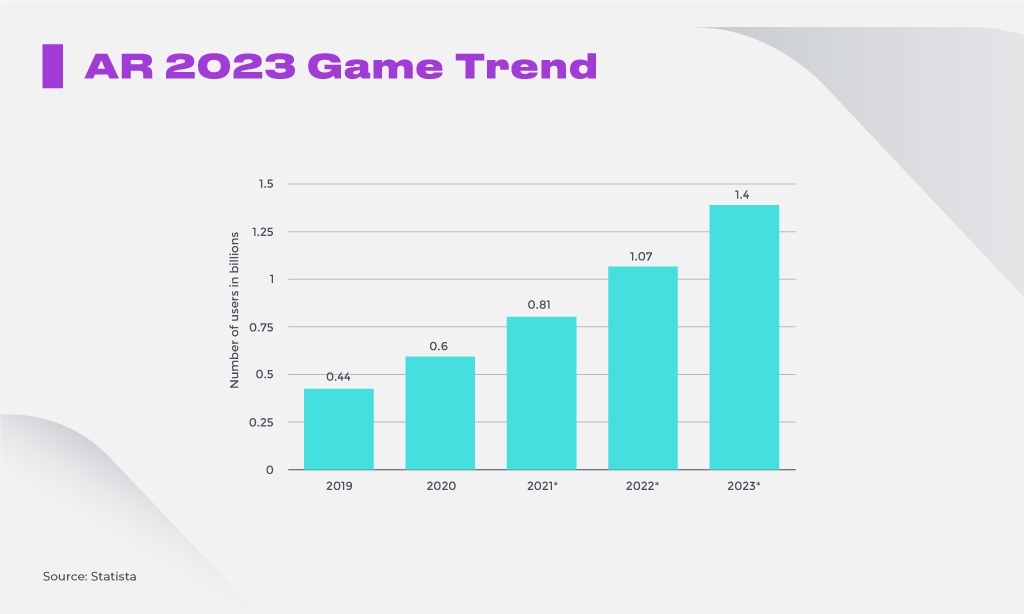
When we take a look at gaming from a technical perspective, we see game development companies who have to work harder to meet those high users’ expectations. To prosper and captivate more gamers, the industry must evolve. That’s why the techniques that were popular ten years ago gradually become outdated. This is what happened to a game design document.
Still, some companies are sure it is vital to have a centralized document that demonstrates your plans and project details before diving into the development phase. We’re going to find out the benefits of using GDD, show its commonplace structure, and give some tips on how to make it a really practical thing.
What Is A Game Design Document?
The topic that is highly disputed today among representatives of the gaming sector is the importance of a game design document (GDD). A GDD is a detailed guideline where game publishers summarize all the game-related information – from the concept and idea of a future title to the roles assigned in a development team. In modern agile-driven projects, a GDD often undergoes alterations and updates during the production phase.
Some executives believe that the GDD, if done properly, helps developers to perform tasks faster and more accurately. In addition, it ensures seamless interaction between various departments and specialists collaborating on the same project.
GDD can ease the work of everyone engaged in game design in terms of understanding all features, gameplay, characters, and other assets. Others might think it’s a waste of time and effort because it’s hard to predict the flow of the development process.
The Importance Of A Game Design Document
While the rationale for using GDD has been questioned, there are some benefits to consider. In real life, a game design guide can be convenient and perform many functions, namely:
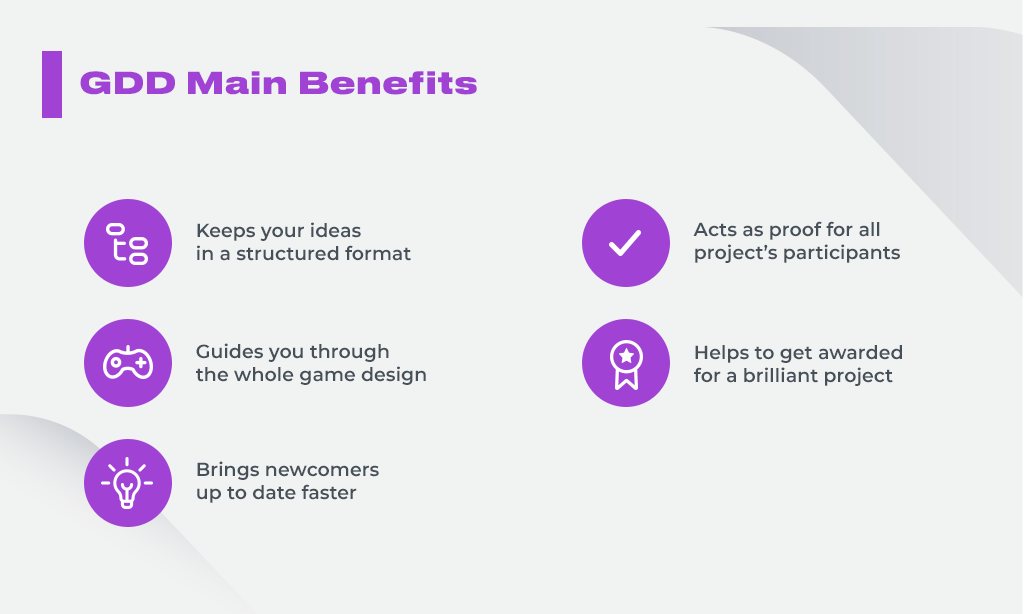
Structure and organize your ideas
Interpreting ideas into a written form can help to have a deeper vision into the future title and make your decisions more confident. When thoughts are captured on the paper, you can better evaluate them and see what needs to be fixed. It’s easier to discuss complicated projects when visualized, be it physical paper or a digital version with graphics.
Visual perception of information works better for humans. In fact, our brain processes images 60,000 times faster than text. Moreover, 90% of information transmitted to the brain is visual. Therefore, we can use this ability to improve data processing and organizational productivity.
Guide you through entire game development
Often games undergo many changes during the production phase splitting into various directions. This is a normal thing for game creation, as the creators have to shift from the initially developed models. To keep track of all changes and avoid chaotic actions, the GDD serves as a perfect assistant. Because the GDD incorporates all major components of the game design, the teammates can use it as a reference and see what was planned initially and what has changed. Thus, all the decisions will be weighed and made more accurately.
Faster bring newcomers up to date
For those working on the game creation from the beginning, many things are obvious. In case newcomers join the project, the onboarding can appear to be challenging without a detailed guideline. That is why keeping a GDD up your sleeve might streamline the engagement of new specialists.
Be proof for all participants
The GDD’s adherents prefer their plans and details to be documented. The GDD might also contain the contract deliverables, allowing all parties to see what results to expect and know the responsible individuals. In such a way, the document acts as a proof for all participants. Besides, when you decide to cooperate with giant game distributors like Sony, you’ll be asked to provide documentation with a detailed outline of the game.
Help win a grant for a successful game
To receive government grants, game publishers must provide a comprehensive business plan and in-depth GDDs. This is to protect a state and government from possible misuse. They often lack the contractual guarantees shielding them from developers who eventually misappropriate resources.
Diving Into Structure Of GDD
The document usually starts with the general blueprint of the project – a so-called summary, including game type (hyper-casual mobile, pc game, tablet game, console game, etc.) and genre (platform games, shooter games, adventure, role-playing., action RPG, MMORPG, etc.). This section is voluntary and doesn’t require a precise specification, but of course, you can add as much information as you need. The following template showcases what core pillars a GDD should include and helps you create your own guide tailored to specific business needs.
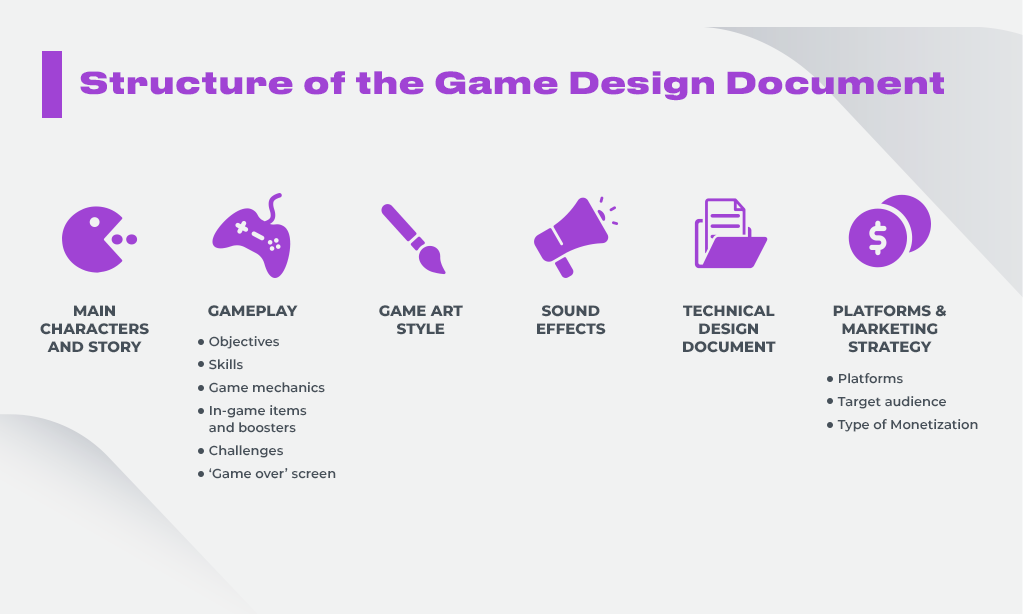
1. Main Characters And Story
Describing the story and characters is the most vital part, coming prior to all the other sections of GDD. A game’s success heavily depends on how interesting and captivating the story is. It can have even more impact than a film. A compelling video game story should incorporate a mix of components that create an immersive, interactive experience for players.
Thoroughly think over the major characters – protagonist, antagonist, companions, and other game-relevant figures. After this, flesh out the most prominent events occurring during the game.
2. Gameplay
It’s crucial to highlight the gameplay in a GDD as this term defines the skills gamers need, the way the game is played, game mechanics, the goals and how to achieve them, overall experience with losses and wins. The gameplay should be addictive and enjoyable to attract as many players as possible.
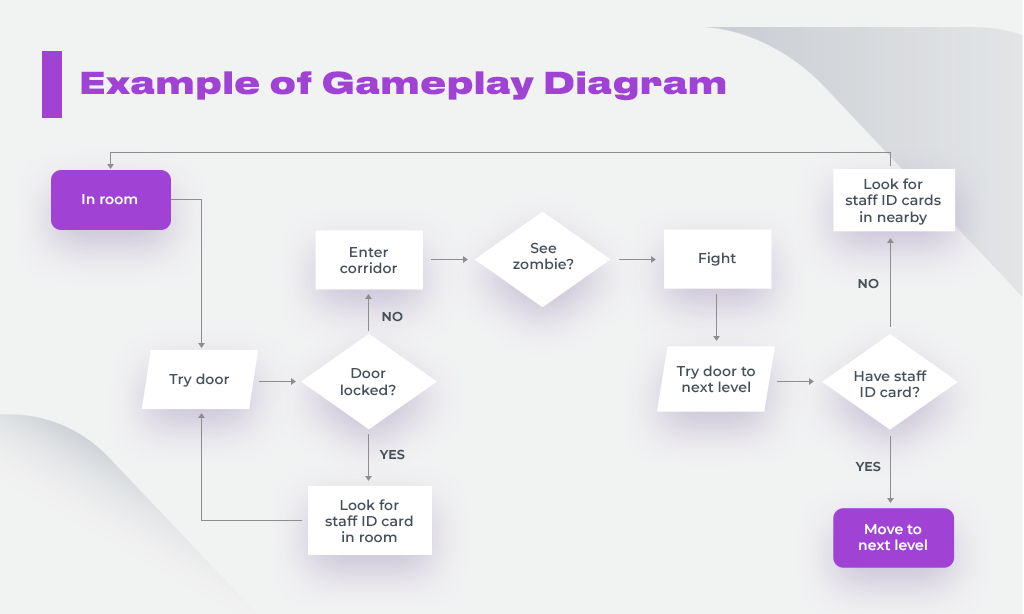
The following components can be included in this part:
Objectives: Add objectives that will explain why a gamer should play the game and what goal they should pursue.
Character skill-set: Describe the abilities a character should have in order to complete the game. This way, you’ll probably find out the voids in your design. For example, it can happen that your game doesn’t fit children. Or vice versa, the game is too easy to play for adults. Skills required may be screen tapping, dragging, memorization, puzzle-solving, strategy development.
Mechanics of a game: This is a thorough guide of rules, moves, actions for users to play a game. You can also mention the challenges and consequences of the performed actions. Common mechanics are taking turns, taking the random chance, capturing and eliminating, bidding in an auction, racing the clock, and so on. Articulate this in your GDD so that your team has a complete picture of what the gameplay should be like.
Props and boosters: This part is used to refer to smaller but equally important elements of the game, such as in-game items needed to empower the player and make the gameplay more enjoyable.
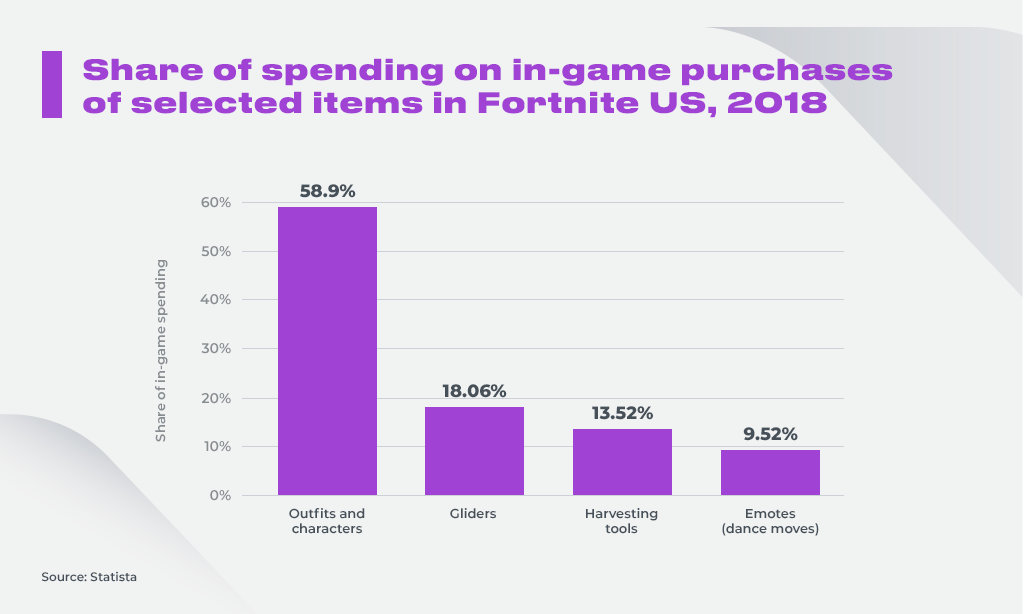
When it comes to monetization, game items play a crucial role, as they can be paid content for players and be the most profitable source of generating revenues. Interestingly, almost 60% of all Fortnite spendings was intended for in-game outfits or characters.
Obstacles: This is not a necessary thing to mention. But if you feel like your GDD should contain the information about what challenges are prepared for gamers, then do it. The idea is to see how characters cope with difficulties as the gameplay proceeds and to ensure the players can obtain the essential tools to keep up with the game’s pace.
Game over screen: Optionally, you can set out this section: what happens after defeat, what users should do, how to recover, etc.
Engagement and revenues will continue to thrive through 2023:
- global players’ number is still on the rise (2.5 players on mobile, 1.3 players on PC, and 0.8 – on console);
- improved Internet infrastructure will bring more engaged users, hence they will produce more in-game revenues;
- more affordable smartphones assist in top titles spread greatly.
To recap, 2023 is expected to mark a major milestone for the global game market.<
3. Video Game Styles
Game art styles are used to describe the visual appearance of characters, objects, items, and other in-game elements. See how the choice of art style differs in top gaming markets.
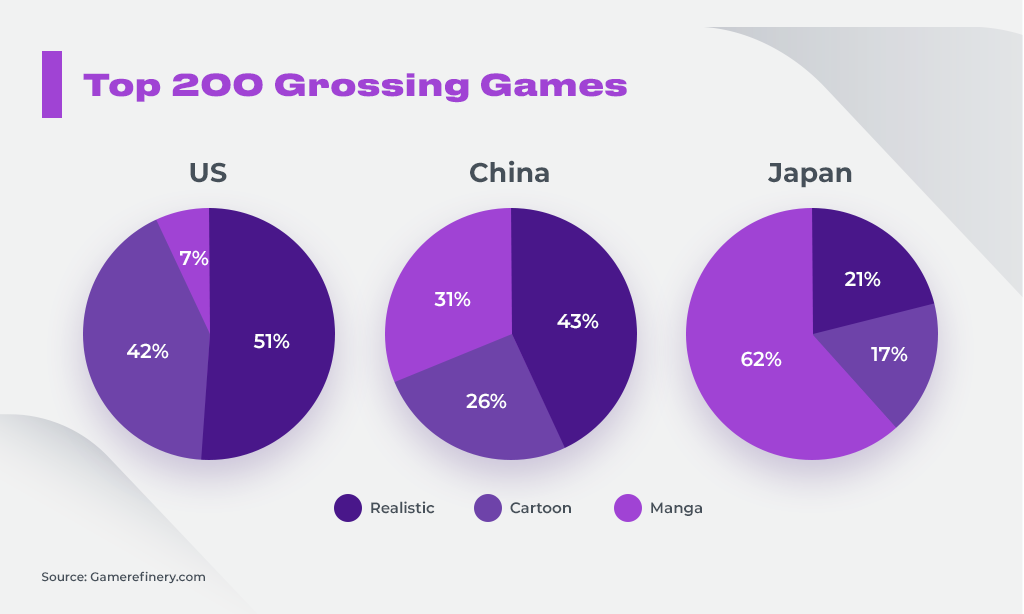
For example, US publishers prefer realistic and cartoon styles. The manga style (comics or graphic novels originating from Japan) is the number one choice for more than half of Japanese game companies (62% of the top-rated 200 titles). The Chinese market’s biggest share goes to realistic with manga art styles, closely followed by cartoon style.
4. Music Effects
Here is where you flesh out your video game music. Except for visuals and interactivity as two core elements of any modern title, there is one more – sound, and specifically music. It transforms gameplay into something beyond an activity that makes a player’s experience unforgettable.
5. Outline of Tech Requirements
Writing technical specs is another essential thing. This type of guide is called a technical specification document containing a set of technologies and tools required to implement the game design features. This document facilitates the work of engineers as they have a full understanding of software and hardware requirements. You can split the two docs – GDD and TDD – or create a single game technical design document.
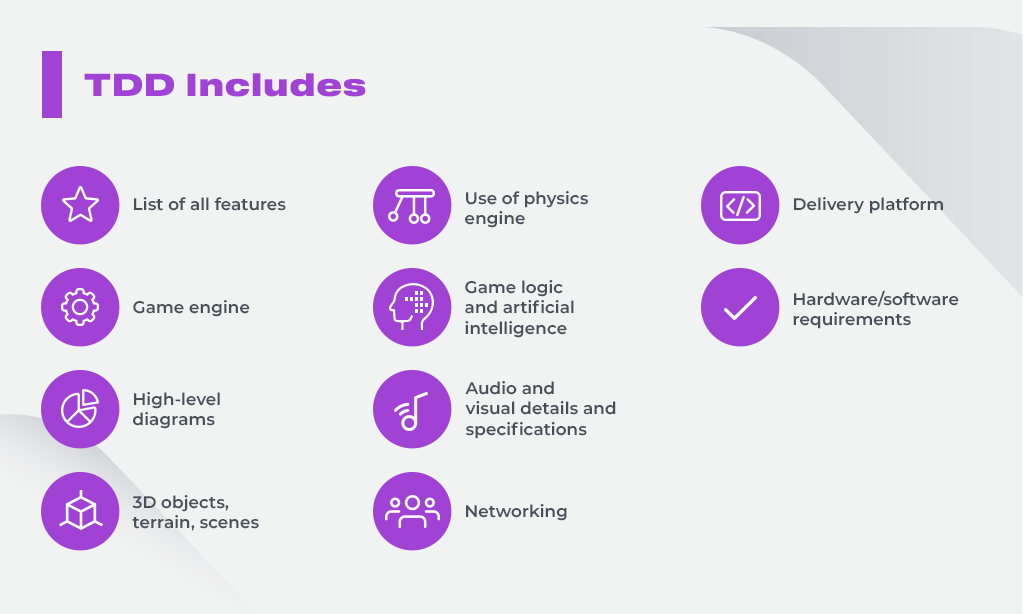
6. Platforms & Marketing Strategy
If you have distinct ideas about how to promote your game before the development process, write them down. Here you outline monetization types, marketing campaigns, target audience (TA), and other approaches to drive revenue up.
Also, make an effort to find funding sources. For example, there can be government funding to apply for. In addition, you can start a YouTube channel, Instagram account, and other social media for promotion in advance.
Platforms: Describe which platforms you are going to use for publishing: Android, iOS, Windows, Xbox, Sony PS, etc. Whether you release the game on a single platform or it will be a cross-platform game development – ensure you’ve specified this information in your GDD.
Target audience: Define whom to target – this directly affects the game design. If you are reaching out to millennials (18-32 years old), create your characters and in-game environment accordingly.
Consider the fact that 70% of the players are aged over 18, and 6% percent are 65 years and older, and 60% of Americans play video games daily. No wonder, the generations grew up with video games as an integral part of their lives and the age of the average gamer also increases.
Type of Monetization: There are many ways to monetize your game today. Be it Android or iOS, you can utilize the free-to-play model with mobile in-game ads, rewarded videos, banners and interstitial ads, seasonal digital pass, loot boxes, or try the recent trend – audio advertising. If you hesitate about which type of monetization to choose, consider in-game purchases – people are expected to spend US$156.5 billion on in-app items by the end of 2022.
Hopefully, this template of a GDD’s structure will be applicable to your game. Anyway, you are free to choose the sections and components. If having any questions, you can contact Innovecs experts to gain more insight into the process. Our game development specialists can help improve the GDD or create it from zero.
Tips On How to Write A Game Design Document
Agile game development teams consider GDD obsolete and outdated. Still, as outsourced teams are becoming increasingly common, the need for centralized game documentation arises again. In this case, the GDD can be part of an agreement between collaborative parties (client and outsourcing software development company). Take a look at the practical tips on how to write a game design documentation properly.
Tip 1. Discuss your ideas
During the initial phase of the project, the team members usually brainstorm and outline the most creative plans and reflect them on paper. If you write down your ideas, you can come back later and analyze them with a clear mind. You can focus on the greatest suggestions and remove the rest.
This is the time to decide: what’s the purpose of the game; what do you want to achieve; what’s the point of the game, etc. At this creative stage, try to bring out the concept without going much into detail of mechanics.
Also, you can discuss the first prototypes for the game – find out which components work and which don’t. After all, ideas and representations are finalized, add them to the GDD. Keep in mind that all ideas, concepts, and approaches should be tested – you can conduct marketing research among actual users by giving them questionnaires, for example. This will add confidence to the whole team and contribute to the project’s success. It can also result in discovering the best features for your game.
Tip 2. Visualize game design documentation
Outdated and old-fashioned physical documents are in the past. Modern GDDs can be visualized using digital tools. Transforming structure and ideas into an electronic version can help your team members clearly and precisely imagine GDD and see how its components interact with each other. As the GDD may collect more details during the game development, it’ll be easier to keep track of all changes using the digital version.
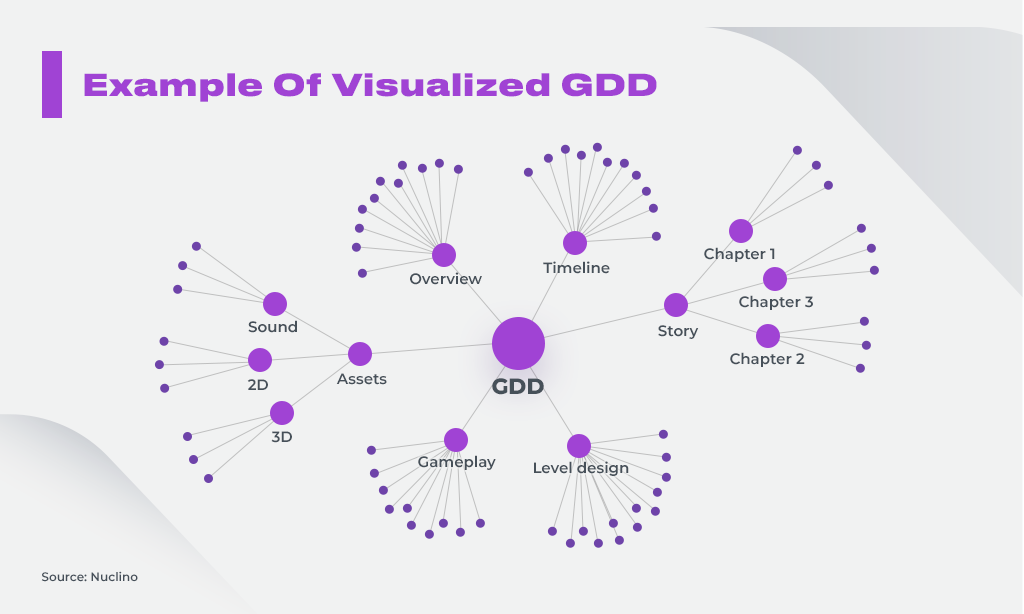
Tip 3. Finalize your GDD
When you discuss the possible plans and game concepts at the brainstorming phase, it’s good to let your creative juices flow. But each guideline of game design with its technical descriptions and marketing strategy has to be accomplished.
This will save you more time and prevent failures at the end of the project. So, finalize the game mechanics, the story, the characters, and other critical assets (styles, sound, animations). The GDD should be a shield from the flood of constant changes that can cause adverse effects on game creation. This approach is best suited for engineers working with the waterfall model, where each phase has specific deliverables and detailed documentation.
Tip 4. Keep it collaborative
Despite trying to protect your GDD from unwanted alterations, the document should be open, collaborative, and convenient for resolving various issues together with all team members.
For example, if using the digital version, you can mention your colleague in the doc, ask for advice, and discuss the problem or idea. The more your colleagues are engaged in the game design process, the better they know the game’s specifications and drive the project to final success.
Tip 5. Leave room for change
Unlike classical game development teams, agile projects’ participants will need a GDD only if it can be changed and refined whenever they need it. For them, this doc has to be a living and evolving asset. With no opportunity to make modifications to the GDD is a horror for such teams. Choose what is best for your business – a reliable and rigid GDD or flexible documentation, open for fluctuations and updates.
Summary: Effectively Run Your Game Project With a GDD
A GDD helps bring the key parts of a game design together. It records the main ideas, contains descriptions of gameplay, critical assets like art styles or sound, allows teammates to visualize the plan for future work. A GDD can act as a good assistant for big projects, involving dozens of employees.
We provided you with a general template for creating a solid GDD. But any game development company can choose its approach and use the mentioned structure optionally. However, the following recommendations can still be helpful:
- Make the game documentation straightforward. The GDD should be easy-to-use for every employee involved in the game development. Don’t describe too many details, be short and concise with your ideas.
- Keep the GDD interactive. Collaboration is key to well-done work. Allow your colleagues to work on the document together. This is especially suitable when using a digital version of GDD.
- Depending on the project, finalize the GDD or keep it flexible to changes. Agile teams will prefer to work with evergreen documentation, while traditional projects would choose to use an accomplished and rigid guide to game design.
- Make your GDD visual. Today’s GDD should be one hundred percent visual, making the collaboration easier between coworkers. Also, all modifications are well seen in an electronic version. Using text docs is boring. People will better perceive the documentation with vivid graphics, diagrams, etc.
If you want to effectively organize your game development process, you can entrust this task with Innovecs experts. The eight-year experience in designing more than 200 games of any type for clients globally makes us a trustworthy partner. Consider delegating your project to us and we will satisfy your most sophisticated requirements.